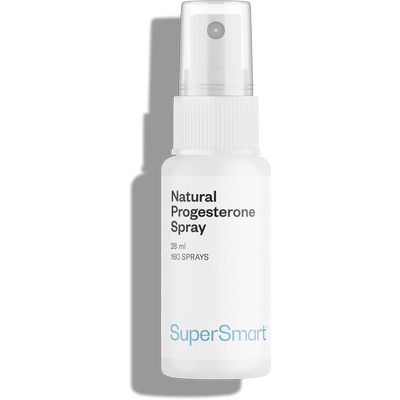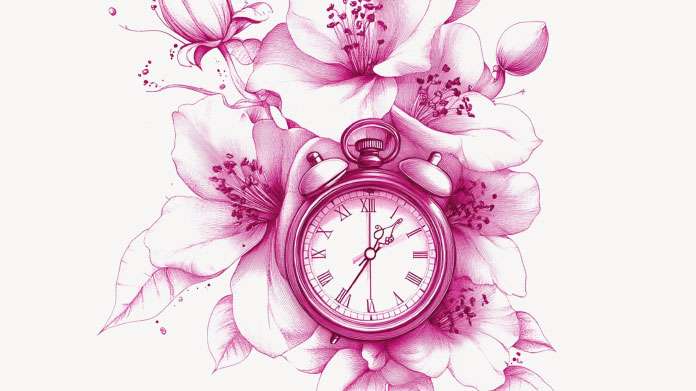Hot flushes in women: why do they happen? What can you do to relieve them?
Suffering from unpleasant hot flushes, ladies? Discover what causes these symptoms and how to reduce them naturally.

What exactly is a hot flush?
A hot flush (or ‘hot flash’ in the US), sometimes referred to under the umbrella term ‘vasomotor symptoms’, is a sudden, transient feeling of heat, most often felt in the upper body (the face, neck and chest).
Hot flushes can be mild, but they can also be very uncomfortable.
The different symptoms of a hot flush
Specifically, the common symptoms of a hot flush are:
- a sudden sensation of heat spreading to the chest, neck and face;
- redness and/or blotchy skin;
- an increased heart rate;
- sudden sweating mainly in the upper body;
- a sensation of coldness once the hot flush has subsided;
- a feeling of anxiety.
Both the frequency and intensity of hot flushes vary over time and depending on the individual. An episode can last 1-2 minutes, or sometimes as long as 5 minutes.
What causes hot flushes, especially in women?
The potential causes of hot flushes in general include side-effects from certain drugs, thyroid problems, anxiety, etc.
There are also factors that can intensify these vasomotor symptoms:
- smoking;
- obesity;
- heredity.
In women, however, hot flushes are often seen at times of hormonal fluctuations during the premenstrual period or menopause (the stage that marks the end of a woman’s reproductive life and corresponds to a permanent absence of periods for at least 12 consecutive months).
Most research suggests that this type of female hot flush occurs when a fall in oestrogen levels makes the body’s thermostat (hypothalamus) more sensitive to variations in body temperature, even slight ones. When the hypothalamus judges the body to be too hot, it triggers a chain of events to make it sweat and cool down.
When do these hot flushes occur?
Hot flushes in women due to hormonal changes can occur at any time of the day or night.
Most women who report experiencing them suffer them on a daily basis.
Nighttime hot flushes are often considered to be particularly intolerable, especially as they interfere with sleep.
How many years do female hot flushes last?
On average, menopause-related hot flushes continue for 7 years, though some women experience them for more than 10 years.
In most cases, they come to a stop after the age of 65. It’s also worth noting that not all women suffer hot flushes during the menopause.
What can you do to reduce menopause-related hot flushes?
There are various natural approaches that can help minimise the frequency and intensity of hot flushes during the menopause:
Some practical advice
First and foremost, try to stay cool. Wear lighter, breathable clothing and cool yourself down with cold towels, cooling sprays…
Make sure you eat a varied, balanced diet, avoiding spicy foods, hot drinks, and alcohol, as well as smoking, which can all contribute to hot flushes.
Take regular exercise to support your general well-being and learn to relax.
Phytoestrogens
Phytoestrogens are compounds naturally present in certain plants such as red clover, soybeans and flaxseeds.
While not exact substitutes for endogenous oestrogens, these compounds have a similar chemical structure. They are able to bind to oestrogen receptors, exerting oestrogenic activity, which compensates for the fall in oestrogen levels linked to the menopause.
They therefore seem to be effective at reducing hot flushes in some women. They can be found in the form of phytoestrogen-rich creams (1).
Progesterone
As well as a fall in oestrogen levels, women going through the menopause also experience a decrease in progesterone.
Supplements containing phyto-progesterone, usually obtained from the plant wild yam, help to compensate for this progesterone shortfall and may thus help to prevent hot flushes (2-3).
Try, for example, our natural progesterone spray or natural progesterone cream.
Vitamin E
A recent meta-analysis showed that, compared with a placebo, the antioxidant vitamin E combined with omega-3, was able to reduce the intensity of hot flushes (4).
Sage
Sage is traditionally used to alleviate hot flushes. Several studies appear to support such use, suggesting it may reduce both their frequency and intensity (5).
St John’s Wort
A lesser-known fact is that, in addition to being used for supporting mood, St John’s Wort is increasingly being studied for its potential effects in countering hot flushes (6). Be sure, however, to seek medical advice before starting any supplementation.
SUPERSMART ADVICE
References
- Chen MN, Lin CC, Liu CF. Efficacy of phytoestrogens for menopausal symptoms: a meta-analysis and systematic review. Climacteric. 2015 Apr;18(2):260-9. doi: 10.3109/13697137.2014.966241. Epub 2014 Dec 1. PMID: 25263312; PMCID: PMC4389700.
- Prior JC, Hitchcock CL. Progesterone for hot flush and night sweat treatment--effectiveness for severe vasomotor symptoms and lack of withdrawal rebound. Gynecol Endocrinol. 2012 Oct;28 Suppl 2:7-11. doi: 10.3109/09513590.2012.705390. Epub 2012 Aug 1. PMID: 22849758.
- Regidor PA. Progesterone in Peri- and Postmenopause: A Review. Geburtshilfe Frauenheilkd. 2014 Nov;74(11):995-1002. doi: 10.1055/s-0034-1383297. PMID: 25484373; PMCID: PMC4245250.
- Maghalian M., Hasanzadeh R., Mirghafourvand M. The effect of oral vitamin E and omega-3 alone and in combination on menopausal hot flushes: A systematic review and meta-analysis. Post Reprod. Health. 2022;28:93–106. doi: 10.1177/20533691221083196.
- Bommer S, Klein P, Suter A. First time proof of sage's tolerability and efficacy in menopausal women with hot flushes. Adv Ther. 2011 Jun;28(6):490-500. doi: 10.1007/s12325-011-0027-z. Epub 2011 May 16. PMID: 21630133.
- Abdali K, Khajehei M, Tabatabaee HR. Effect of St John's wort on severity, frequency, and duration of hot flashes in premenopausal, perimenopausal and postmenopausal women: a randomized, double-blind, placebo-controlled study. Menopause. 2010 Mar;17(2):326-31. doi: 10.1097/gme.0b013e3181b8e02d. PMID: 20216274.
1 Days
Fast delivery
very quick delivery to italy. product is good.
Customer
2 Days
Prompt delivry !!👍
Prompt delivry !!👍
SWEET Christine
2 Days
Good delivery and flawless quality
AS far as delivery and the visual quality are concerned, Supersmart is excellent. I will not comment on the efficacy of the products themselves, since that is only possible over a longer period and in a large customer base compared to people who do not consume a particular product.
Roger De Backer
3 Days
Perfect services
Perfect services, perfect support, great articles about products
Michaela Alali Beitlová
4 Days
Great experience and effective supplements
I’ve purchased many types of supplements from this company over the course of years to treat a few issues, and I’m satisfied with their quality. After using them consistently for a period of time, I can say they met my expectations and I could feel real health benefits that built up over time. Deliveries are always quick. I recommend this company to anyone looking for high-quality supplements.
Giordano
4 Days
Es hat alles gestimmt
Es hat alles gestimmt. Top
marina thieme
7 Days
Great product
Great product, but still evaluating its effectiveness. Highly recommended. Super efficient delivery.
Chalise
11 Days
Quality products
Quality products , efficient and effective customer service. You can’t ask more
CLaudia
17 Days
Good quality product and customer service.
So far, I'm liking this product, and the customer service was very good.
ELZL
24 Days
The products I use are excel·lent
The products I use are excel·lent
ROSAS Josep Maria
32 Days
Delivery is prompt and I never saw a…
Delivery is prompt and I never saw a quality problem with the manufacturing. It is not possible to assess efficacy on a personal basis, since too many factors come into play. Efficacy can only be assessed statistically with a sufficient number of cases.
Roger De Backer
33 Days
I collaborates with the Supersmart…
I collaborates with the Supersmart more than 10 years. Every thing is going good. Quality of the things is good. Delivery comes in time. Five stars definitely !!!
Oleksiy
33 Days
All good
Simple, frictionless site, easy ordering, good delivery updates and execution.
Chris Robbins
35 Days
I feel better
I feel better
Peter Ammann
35 Days
Prompt delivery
Prompt delivery
JAKUB Radisch
of experience
your money back
##montant## purchase








